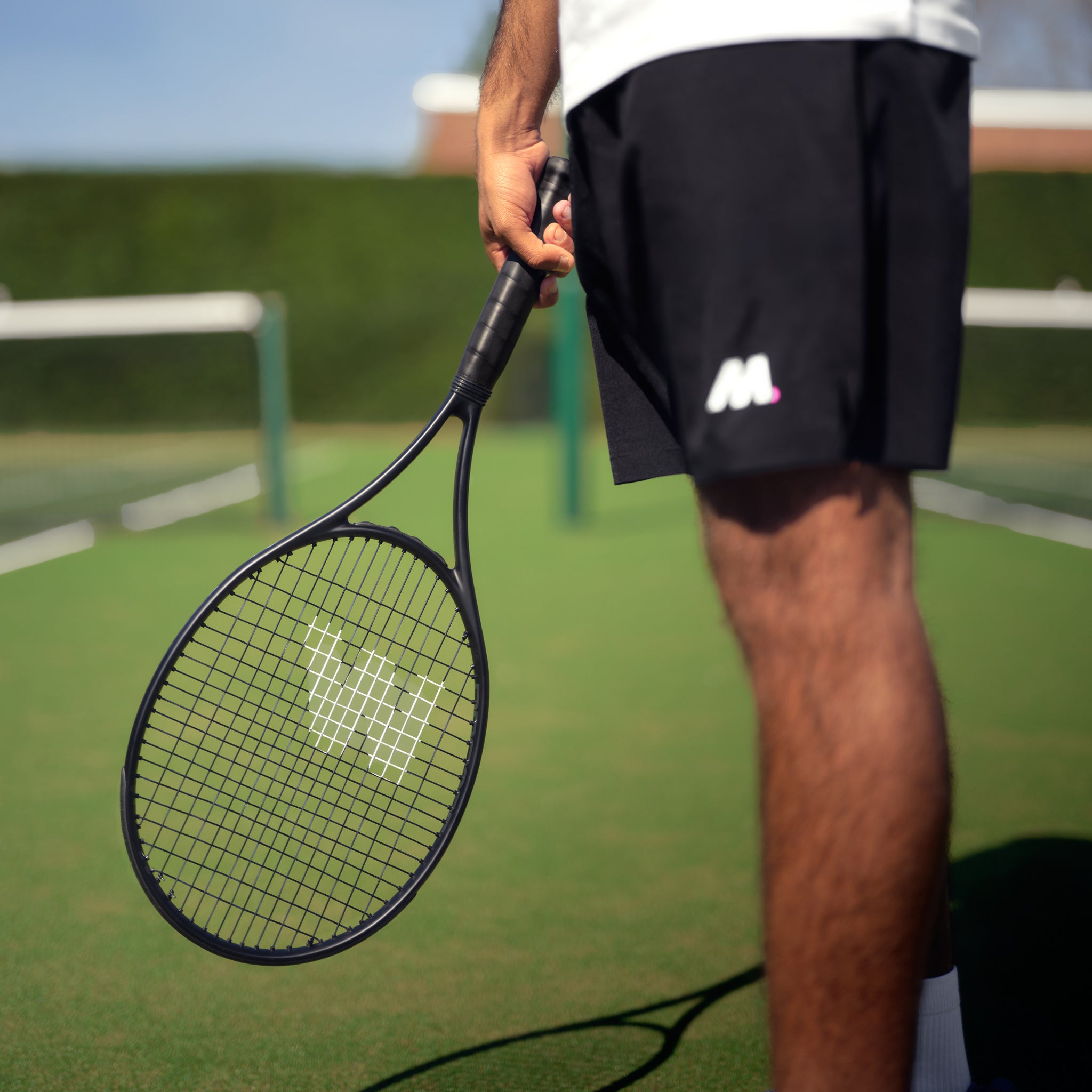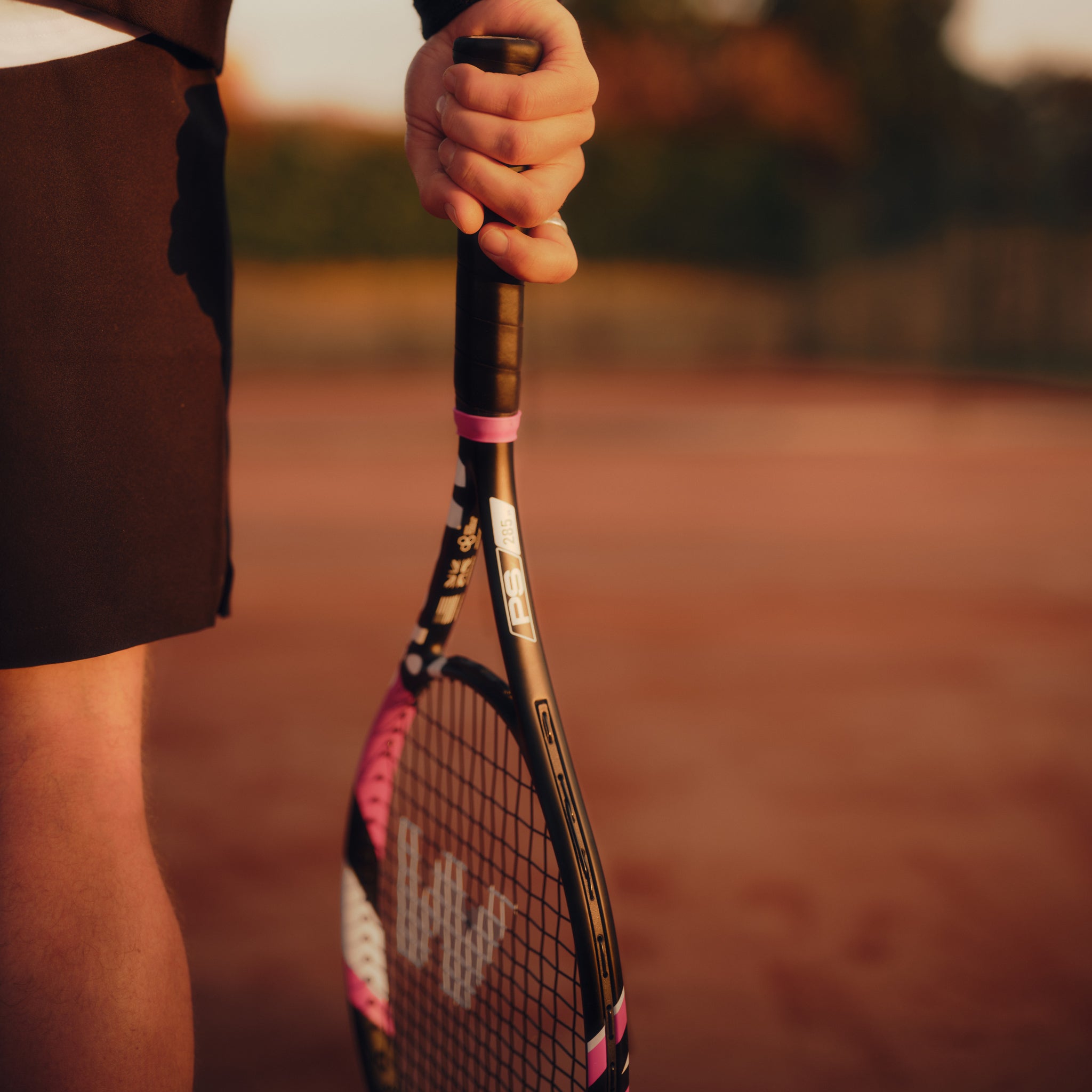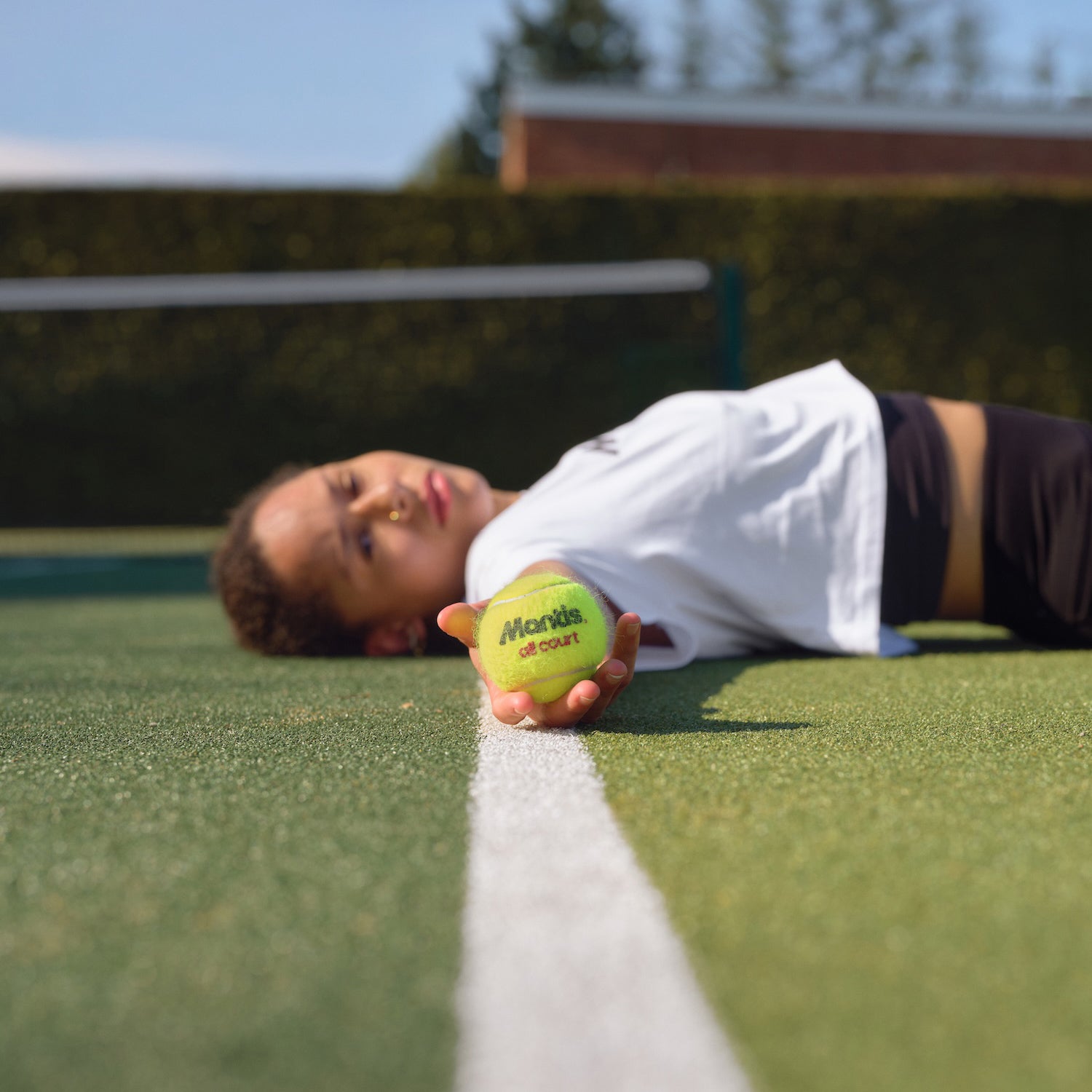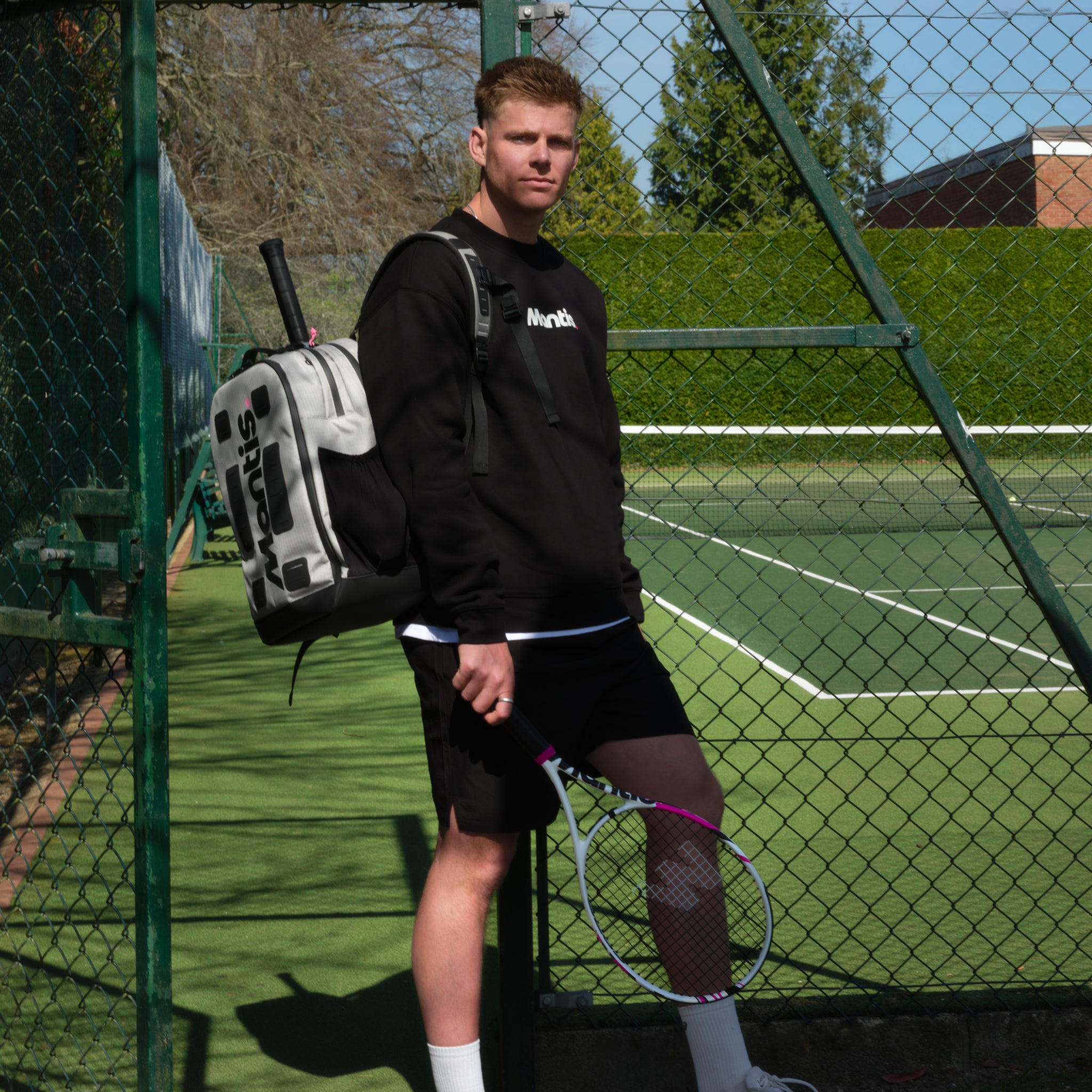
Choosing a tennis racket is a bit like a dark art, but at Mantis, we believe it really just boils down to one thing: matching the racket's specs to your game. When you Shop the Mantis Tennis Collection, think head size, weight, and balance. A newcomer needs a forgiving frame with a big sweet spot, while a seasoned competitor needs a precise, heavier tool for surgical shot-making. Get this balance right, and you're already halfway to finding the perfect racket.
Choosing a tennis racket starts with your game
Before you even start browsing, the first and most crucial step is a bit of honest self-reflection. A racket isn't just a piece of kit; it's an extension of your arm. The ideal frame will amplify your strengths and shore up your weaknesses, but you have to know what those are first.
Define Your Skill Level
Let’s be realistic about where you stand right now. It's tempting to buy a racket for the player you want to become, but you need one that works for the player you are today. Your needs will evolve, so choose accordingly.
- Beginner: You're just getting started, working on the fundamentals of hitting the ball consistently. You need a racket that does some of the work for you, offering easy power and a generous sweet spot for those off-centre hits.
- Intermediate: You can hold a rally, you're starting to add variety to your shots, and you might be playing club matches or in a local league. You're looking for a great all-rounder—a racket that balances power with control.
- Advanced: Your strokes are grooved, you create your own pace, and you're competing at a high level. Precision and feel are your top priorities, so you'll want a racket that gives you ultimate control over the ball.
Identify Your On-Court Style
Next, think about how you play. Are you a baseline warrior, crushing groundstrokes from the back of the court? Or are you a creative all-courter, mixing in slices, drop shots, and trips to the net?
A powerful baseliner with a long, flowing swing needs something very different from a player who relies on touch and placement with a shorter, more compact swing. Your natural swing speed is also a huge factor. If your swing is fast, you generate your own power and need more control from the frame. If it’s a bit slower, you’ll want a racket that helps you create pace. This kind of self-awareness is your best tool for narrowing the field, a point often emphasised by the team at Racket Business.
At Mantis, we’ve always believed the best racket isn't the most expensive one or the one your favourite pro uses. It’s the one that feels like an extension of your arm, giving you the confidence to play your best tennis.
It's also worth noting what's popular in the market. The data is telling: ‘tweener’ rackets, which give a fantastic blend of power and control, make up a massive 41.2% of global racket revenue. They're a hit for a reason, appealing to a huge range of intermediate players.
Control-focused frames aren't far behind, accounting for 35.9% of sales, while pure power rackets take up 23%. This just goes to show how vital it is to match the racket category to your game instead of just grabbing the latest model off the shelf.
Getting to Grips with Racket Specs and What They Mean for Your Game
The technical details printed on the side of a racket can look like a foreign language. Honestly, all those numbers and terms can be intimidating. But once you understand what they mean, they tell you exactly how that frame is going to feel and perform in your hands.
Here at Mantis, we’re big believers that cutting through the marketing noise starts with knowing your specs. It’s the single best way to find a racket that truly works with your game, not against it. For a deeper dive into how this all connects, our article on tennis racket materials is the perfect next step.
Let's break down the most important numbers you’ll see.
Head Size: The Balance Between Power and Forgiveness
First up is head size, measured in square inches. This is simply the size of the hitting area. A larger head size gives you a bigger sweet spot—that prime area in the centre of the strings where you get the cleanest hit. This translates to more forgiveness when you don't catch the ball perfectly.
This infographic lays out the three main categories and what they offer.
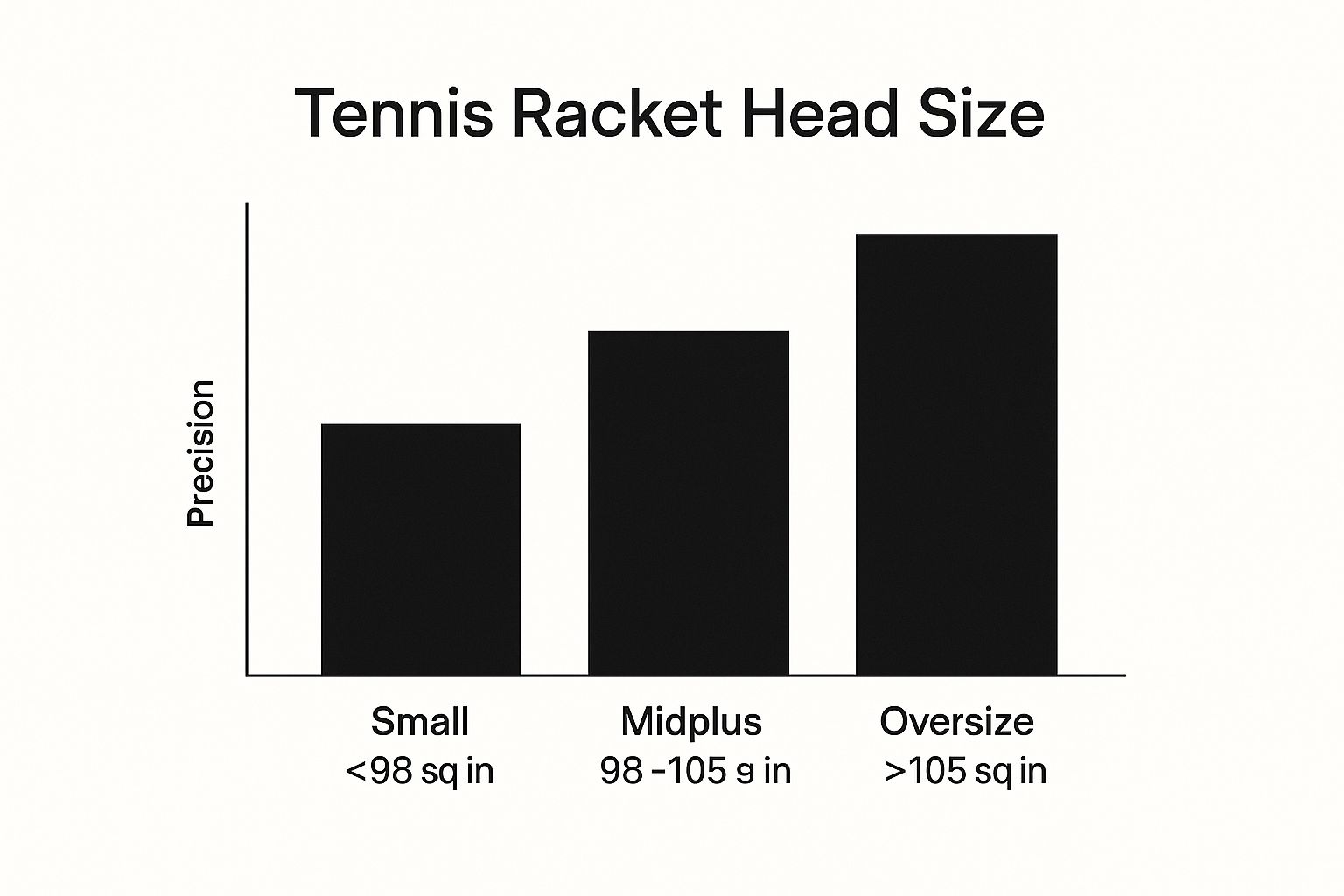
As you can see, it's a classic trade-off. You're essentially choosing between the raw power and forgiveness of a larger head or the pinpoint precision of a smaller one. It’s a fundamental decision when you're figuring out how to choose a tennis racket.
Weight and Balance: Finding Your Perfect Feel
A racket's weight (usually somewhere between 250g and 320g) and its balance point are a tag team. They work together to define how the racket feels to swing. The weight itself gives you stability behind your shots, while the balance dictates where that weight sits.
It breaks down like this:
- Head-Heavy: More of the mass is loaded into the head of the racket. This helps generate easy power, making it a great fit for players who have shorter, more compact swings and need a bit of extra oomph.
- Head-Light: The weight is concentrated more towards the handle. This makes the racket incredibly easy to whip around, perfect for fast reactions at the net or generating high swing speeds from the back of the court.
- Even Balance: Just as it sounds, this is the middle ground. It offers a fantastic blend of stability and manoeuvrability, which is why it’s a popular choice for all-court players who need a bit of everything.
Stiffness and String Pattern: The Keys to Feel and Spin
Next, let's talk about the frame's stiffness, which is given an RA rating. This number tells you how much the racket bends when it makes contact with the ball. A stiffer frame (think an RA over 70) flexes less, sending more power back into the ball but with a much firmer, crisper feel. On the other hand, a more flexible frame (with an RA under 65) absorbs more of the impact, giving you better comfort and a more connected-to-the-ball sensation.
The string pattern is just as critical for feel and, especially, for spin. The two you’ll see most often are 16x19 and 18x20. The team at Racket Business always has great insights on the latest equipment trends if you want to explore this further.
A more open pattern like 16x19 allows the main strings to slide and snap back more dramatically on impact. This is the secret sauce for generating heavy topspin. A denser, more closed pattern like 18x20 offers a more controlled, predictable response, which is often preferred by players who hit flatter and value precision above all else.
Racket Specifications at a Glance
To tie this all together, here’s a table that breaks down the typical spec ranges for different skill levels and what it all means for your game on the court.
| Specification | Beginner Range | Intermediate Range | Advanced Range | Impact on Play |
|---|---|---|---|---|
| Head Size | 102+ sq. in. | 98-102 sq. in. | 95-98 sq. in. | Larger heads offer more power and a bigger sweet spot; smaller heads provide more control. |
| Weight (Unstrung) | 250g-280g | 280g-300g | 300g+ | Heavier rackets are more stable and powerful; lighter rackets are easier to swing. |
| Balance | Head-Heavy | Even to Slight Head-Light | Head-Light | Head-heavy improves power for short swings; head-light enhances manoeuvrability for long, fast swings. |
| Stiffness (RA) | 68+ | 65-70 | Below 65 | Stiffer frames are more powerful but less comfortable; flexible frames offer more feel and comfort. |
| String Pattern | 16x19 | 16x19 or 18x20 | 18x20 or 16x19 | Open patterns (16x19) are spin-friendly; dense patterns (18x20) offer more control. |
Looking at these specs in context helps you build a profile of the kind of racket that will best suit your needs, making the selection process far less of a guessing game.
Matching a Racket to Your Ambition and Style
Now that you've got a handle on the technical specs, it's time for the fun part: connecting the hardware to your actual game. We have found the best way to do this is to think in terms of three main racket archetypes and see which one fits you. Figuring out how you play is a huge part of learning how do i choose a tennis racket. If you need a hand with that, our article on understanding your playing style is a great place to start.
Pretty much every racket on the market can be sorted into one of three buckets: Power, Control, or a hybrid of the two, which we often call 'Tweener' rackets. By figuring out which category aligns with your needs, you can cut through the noise and focus only on frames that will genuinely help you on court. It's a much smarter approach than just picking a racket because you like the colour or because your favourite pro uses it.
The Power Racket for Newcomers and Improvers
If you're just getting into tennis or are still working on your technique, a power racket is often your best friend. These frames are specifically designed to make the game easier and more forgiving right from the get-go.
They typically have a few things in common:
- An oversized head (102 sq. in. or larger) for a more generous sweet spot.
- A lighter weight (usually under 280g) so it's a breeze to swing.
- A head-heavy balance which helps put some extra oomph behind the ball.
Picture a beginner learning to hold a rally. Their swing is likely still short and compact, so they aren't generating a lot of their own pace. A power racket steps in to do the heavy lifting, giving their shots easy depth and forgiving them when they don't catch the ball dead in the centre. This really helps build confidence and lets you focus on your form without getting frustrated by mishits.
The 'Tweener' Racket for the All-Court Player
Once your skills start to sharpen, you might feel the need for a racket that can do a bit of everything. This is exactly where the 'tweener' comes in. Think of it as the jack-of-all-trades, blending the easy power of a beginner frame with the finer precision of an advanced one.
Take a typical club doubles player, for example. They need enough pop to hit a solid serve, but also enough feel and quickness for sharp volleys at the net. A 'tweener' racket, with its mid-plus head size (98-102 sq. in.) and more balanced weight, is the perfect solution. It’s built for an all-court game, making you just as dangerous from the baseline as you are up close.
The UK's tennis equipment market, now valued at around USD 150.45 million, shows a real appetite for these advanced, user-friendly rackets. As more players look for frames with bigger sweet spots and better comfort, the 'tweener' category keeps growing.
At Mantis, we see 'tweener' frames as the workhorses of club tennis. They provide the perfect platform for intermediate players to continue developing every aspect of their game without being held back by their equipment.
The Control Racket for the Seasoned Competitor
Finally, we have the control racket. This is for the advanced player with polished strokes and a lightning-fast swing. At this level, the game shifts from creating power to commanding it with absolute precision. Control rackets are the scalpels of the tennis world.
You'll recognise them by these features:
- A smaller head size (98 sq. in. or less) for pinpoint accuracy.
- A heavier static weight (over 300g) to stand up to heavy hitting.
- A head-light balance for exceptional manoeuvrability.
- A thinner, more flexible beam for better feel and feedback from the ball.
Think of a strong junior player moving up to a more demanding frame for high-level tournaments. Their technique is sound and they generate plenty of their own power. What they need now is a tool that gives them total command over the ball, letting them paint the lines with confidence and feel every nuance of their shots. The experts at Racket Business often point out that these are the frames of choice for players who value feedback and a direct connection to the ball above all else.
What Modern Rackets Are Made Of (And Why It Matters)
Tennis rackets today are worlds away from the old wooden frames of the past. They're genuine feats of engineering, and the materials packed into a modern frame have a huge say in how it performs, how comfortable it is, and how it feels in your hand. For a really deep dive, we break down the specifics in our guide to tennis racket materials.
At Mantis, we're big believers that getting a handle on this tech is a crucial part of figuring out which racket is genuinely right for your game.
The backbone of almost every performance racket you'll find is a composite of graphite and carbon fibre. This duo is the magic formula, offering an incredible mix of strength, stability, and lightness that was just a pipe dream back in the wood and aluminium days. It's the reason a racket can generate serious power without weighing a ton, and feel solid on impact without being stiff as a board.
Fine-Tuning The Feel With Speciality Materials
To really dial in performance, manufacturers get clever, weaving in other specialised materials to tweak specific characteristics. You'll often see names like basalt, tungsten, or graphene popping up in racket descriptions, and they're not just there for show.
-
For Vibration Dampening: Materials like basalt are brilliant at soaking up shock. When they're layered into the frame, they act like a filter, stopping a lot of the harsh vibrations from ever reaching your arm. The result? A much more comfortable, arm-friendly feel when you strike the ball.
-
For Rock-Solid Stability: Denser, heavier materials like tungsten are often strategically placed in key spots around the racket head. This adds a good dose of stability without piling on the overall weight, helping the frame resist twisting on those off-centre shots and giving you more predictable power.
This constant push in material science is a massive driver in the sport. The global tennis racket market was valued at $616.72 million and is on the rise, with the UK holding a significant 13.32% market share in Europe. Much of that growth comes from players wanting user-friendly features like better vibration control and bigger sweet spots—things that are especially popular with UK club and recreational players.
Tech That Goes Beyond The Frame Itself
It’s not just about the raw materials. Brands also build unique technologies into their frames to solve specific problems you face on court. These aren't just marketing buzzwords; they're genuine design solutions that can make a real difference to your game.
At Mantis, our philosophy is all about purposeful innovation. We design technologies to do specific jobs, like enlarging the sweet spot for more forgiveness or refining how the frame flexes for a better feel. Every feature has to serve a clear performance benefit for the player.
For instance, you'll see some tech focused on grommet design, allowing the strings to move more freely for a bit of extra pop and spin. Others are engineered specifically to lessen the jolt of an off-centre hit, which is a lifesaver for your arm and helps keep you playing longer.
When you understand what these features are designed to do, you're in a much better position to choose a racket that isn't just built for your style, but is also kitted out for the modern game.
Why You Should Always Demo Before You Buy
You can spend hours diving into spec sheets and reading every review online, and that’s a great start. But all that research only gets you to the baseline. The single most important step in finding your next racket is getting it on court and hitting some balls.
A frame that looks perfect on paper can feel completely alien in your hand. That’s why we’re so big on demoing. The feel of a racket is incredibly personal; two players with identical styles might walk away with completely different opinions on the same frame. It's an experience that numbers and reviews simply can't capture.
To make this vital step as easy as possible for players, we created our demo racquet programme. It’s designed to get the racket in your hands so you can feel it for yourself.
The Right Way to Test a Racket
To get a real feel for a racket, you have to put it through its paces properly. A casual ten-minute knock-up against a practice wall just won’t do. You need to see how it holds up under the pressure of a real game.
Organise a proper hitting session and make sure you cover every shot in your arsenal.
- Groundstrokes: Work through a range of forehands and backhands. How does it feel when you go for a target? What about when you don't quite catch the ball in the sweet spot?
- Serves: Don’t just pop them in. Go through your full-power service motion and see if you can generate the pace you’re used to. Pay attention to how it feels on your arm and shoulder.
- Net Play: Test its reflexes at the net with volleys and overheads. A racket that feels like a beast from the back of the court can sometimes feel clumsy and slow up close.
- Your Go-To Shots: Everyone has them. Whether it’s a killer slice backhand or a tricky drop shot, see if the racket helps you execute your signature plays.
The point of a demo isn't just to see if you can hit the ball well. It's about finding a frame that feels like an extension of your arm—one that gives you the confidence to swing out without a second thought.
What to Pay Attention To
As you hit, try to tune into more than just whether the ball is going in or out. Focus on the actual sensation.
How does it feel at the moment of impact? Is it crisp and responsive, or do you feel a harsh vibration? Gauge its natural power level – does it give you easy depth on your shots, or are you having to muscle the ball over?
And finally, how’s the control? Do you feel truly connected to the ball, like you can place it on a sixpence? Answering these questions on the court is the final piece of the puzzle and your best insurance against buyer's remorse.
Got Questions? We've Got Answers
Let's wrap things up by tackling some of the most common questions we hear from players around the UK. Picking a new racket is a big deal, and getting some clear answers can help you make that final decision with confidence.
How Often Should I Replace My Racket?
There’s no hard-and-fast rule, but if you’re a regular club player, you’ll find the graphite frame starts to lose its punch after about two to three years. The materials simply get tired from thousands of impacts.
You’ll start to feel it. Shots might seem a bit ‘dead’, or you'll notice more vibration travelling up your arm. If a fresh restring doesn't solve the problem and bring that crisp feeling back, it’s probably time to start looking. And, of course, if you see a crack—any crack at all—the frame is done. It's unsafe to play with and needs immediate replacement.
Does Grip Size Really Matter That Much?
Yes, it's a massive deal. In fact, getting the grip size right is one of the most overlooked aspects of choosing a racket, but it’s absolutely crucial for preventing injury and playing your best.
A grip that's too small forces you to squeeze the handle constantly. Over time, this leads to forearm fatigue and is a classic recipe for developing tennis elbow.
On the other hand, a grip that’s too big kills your wrist mobility. You won't be able to get that 'snap' on your serves or generate the kind of topspin that's vital to modern tennis. Pop into your local pro shop; they can measure your hand in seconds and find the size that gives you a relaxed, secure hold.
Should I Use the Same Racket as My Favourite Pro?
It’s incredibly tempting to copy your idol, but honestly, it’s almost always a bad idea. Pro-player rackets are beasts—they are ridiculously demanding and often heavily customised to suit an elite athlete’s game.
These frames are built for people with world-class technique who generate their own immense power. What's more, the version you buy in a shop is rarely the exact one they use. You'll have way more fun and see much better results on court with a racket that’s actually designed for your game, not theirs.
What Is a Realistic Racket Budget in the UK?
You definitely don't need to spend a fortune to get a brilliant frame. For adult graphite rackets in the UK, here’s a rough idea of what to expect:
- £80 – £150: This is the sweet spot for most club players, from improving beginners to solid intermediate competitors. You’ll find some fantastic, high-quality options in this bracket.
- £150 – £250: In this range, you're looking at top-end performance models with the very latest tech, aimed at advanced players who need every possible edge.
Here’s a great tip: keep an eye out for last season's models. They're often nearly identical to the newest versions but come with a hefty discount. Just remember to budget for a set of strings, as most high-performance rackets are sold unstrung.
At Mantis, we live and breathe tennis. We're committed to crafting top-tier equipment for players who are as passionate about the game as we are.
